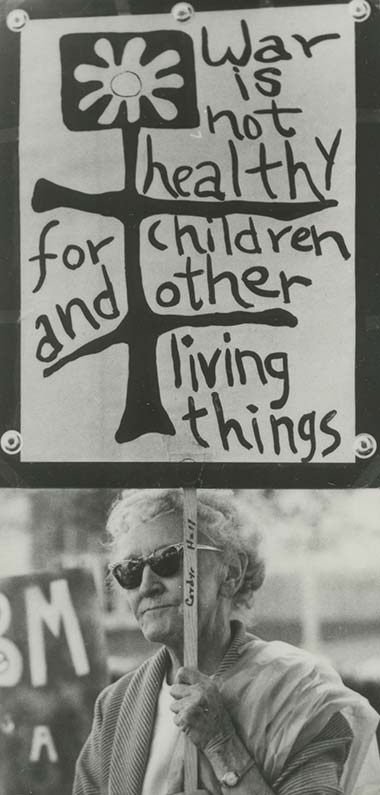Class keeps history alive and accessible

Dec. 7, 2022 - DENTON - Texas Woman's University is teaching a course that's sneaky important.
The Bibliography and Research Methods class, offered by the English, Rhetoric and Spanish program, may not seem that big a deal on the surface. The name sounds tedious. One of those classes students need but don't want. It's not going to lead to curing diseases or solving the mysteries of the universe. But when someone does those things, this is the class that determines how those stories are remembered and told.
It's a course in preserving history. And it just completed a successful test run.
"It's one part how you do graduate level research and one part book history," said Ashley Bender, PhD and assistant professor of English. "I wanted students to do archival work in our special collections, and then make it digital in some way. What we ended up doing, partially because of my own research interests and a lot of the interests of our students, was to focus on women's letters. The class was all gung ho, yes, let's focus on women's letters. So they started to explore various collections."
Bender's spring 2019 edition of the Bibliography and Research Methods class spent months pouring through TWU's collection of donated documents. After a considerable delay due to the COVID pandemic and with the help of the TWU Library's Kristin Clark, manager of the Digital Collections; Corynthia Dorgan, digital asset archivist; and Amanda Zerangue, director of digital strategies and innovation, the efforts and persistence of nine TWU students is now online.
"Moments of Inscription: the Lives of Women Through Their Letters" features selected digitized writings and artwork to shine a light on the stories of nine extraordinary women:
- Edra Bogle: North Texas 1970s LGBTQ+ trailblazer
- Caro Brown: Pulitzer-prize winning reporter
- Rema Lou Brown: feminist, activist, and educator
- Edna Ingels Fritz: fashion forward feminist
- Cordye Hall: Dallas peace activist
- Jeanann Madden: school teacher turned soldier
- Margaret McCormick: patriotic pilot
- Frances Mulkey Keys: educator and adventurer
- Dorothy Scott: pioneering aviatrix
Each section of the exhibit includes reflections from the student who compiled each subject's documents. The reflection is the student's experience working on this project, expressing why they chose these materials, what they felt was important and how these materials impacted them.
It's the latest addition to the TWU Digital Exhibits, joining a dozen collections in the digital archive.
In addition to the help of library staff, one of the students stuck with the project from inception to the conclusion.
"I was the grad student that wouldn't leave," said Beth Headrick, who is now a digital strategies and innovation specialist with the TWU Library.
"We did a class-wide collaborative project where we went into the women's collection, the vaults," Headrick said. "We looked for collections that had not been catalogued or had anything done with them. We pulled out letters and pictures and did transcriptions. We tried to create a digital portrait of who these women were."
"The exhibit really focused on their letters and how those letters draw a portrait of the women and the kind of work they did," Clark said. "It wasn't completely digitizing the entire collection. The students selected interesting pieces that they felt were really representative of these women and what they did. The exhibit highlights the students' work and the lives of these women."
"One of the things that we see when we look at women's writing is even when women weren't writing in a public space or publishing or even circulating poems and things like that in manuscripts, they were writing on a daily basis," Bender said. "They were writing as part of their everyday lives, writing letters to each other, account books and recipe books for the household. Preserving this kind of writing is extraordinarily valuable because it is complementary to the other kinds of literary production of any particular period. If we put these artifacts next to some of the literary productions of a particular period, we have a much larger sense of what was actually happening. It gives us a much better historical record."
Media Contact
David Pyke
Digital Content Manager
940-898-3668
dpyke@twu.edu
Page last updated 8:52 AM, December 7, 2022
/prod01/twu-cdn-pxl/media/images/esfl/Clipping-of-political-cartoon-featuring-Caro-Brown-and-Ken-Towery,-undated.jpg)
/prod01/twu-cdn-pxl/media/images/esfl/Dorothy-Scott-WAFS.jpg)
/prod01/twu-cdn-pxl/media/images/esfl/JEANANN-MADDEN-WITH-A-GROUP-OF-CHILDREN-IN-SAUDI-ARABIA.jpg)
/prod01/twu-cdn-pxl/media/images/esfl/Silk---watercolor-fashion-drawing-for-faculty-stunt-performance-ca-1920s..jpg)